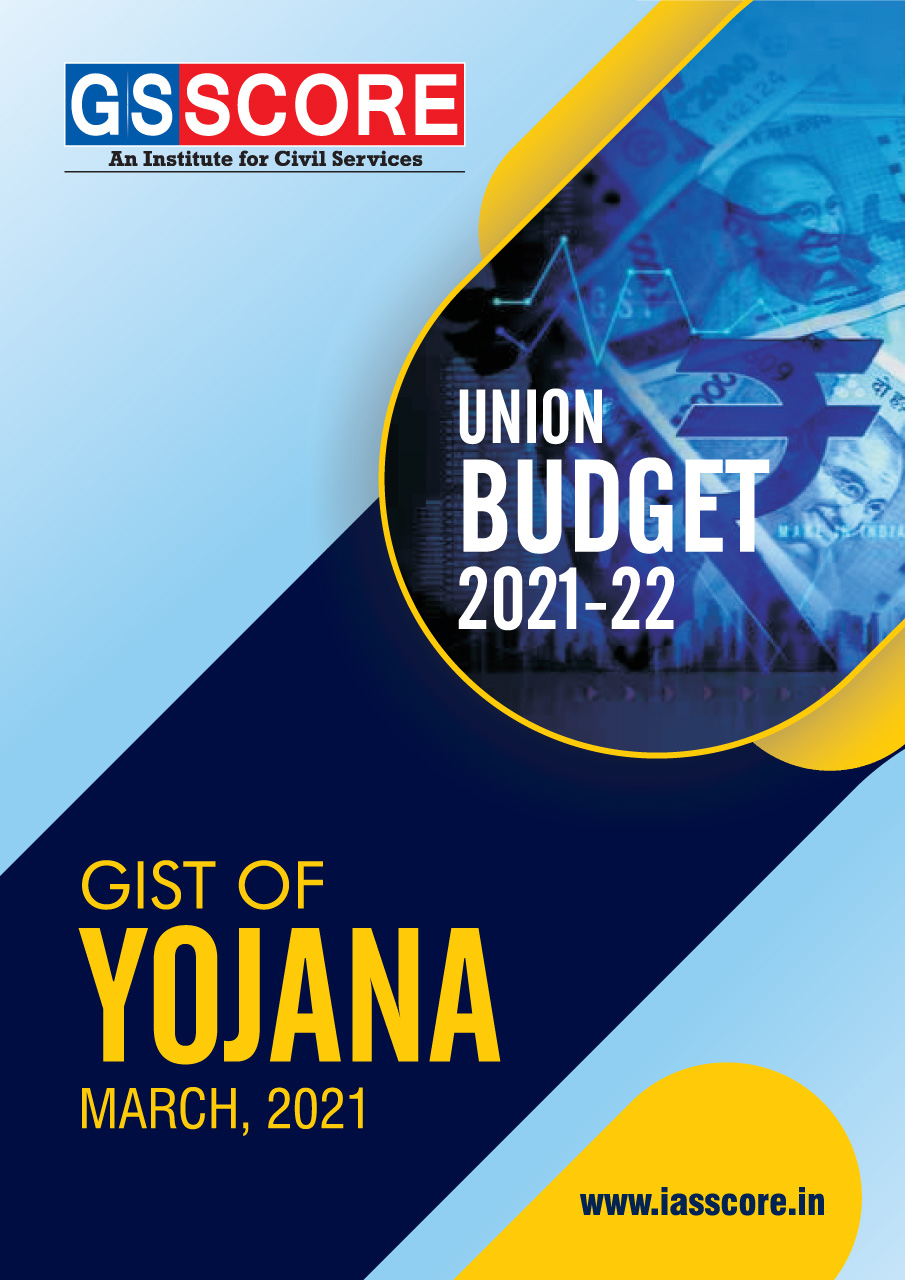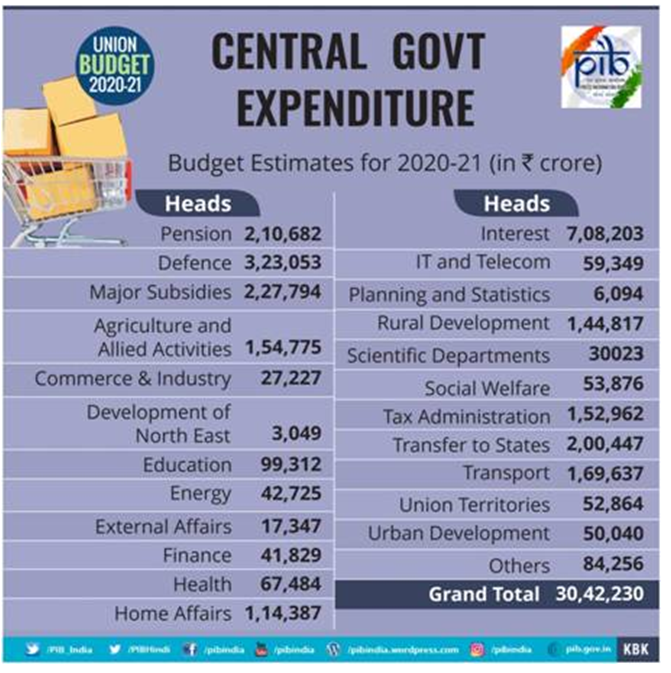


Union Budget 2021-22
Introduction
- The Minister of Finance of the Union has presented the Budget for 2020-21. Given below are important macroeconomic indicators and proposed tax reforms in India.
- Moreover, the Union Budget 2021 lays emphasis on the seven pillars for invigorating the economy
- Health and success
- Physical and Monetary capital and infrastructure
- Inclusive Development for Aspirational India
- Reinvigorating Human resources, Innovate and Research & Development
- Minimum Government with Maximum Governance
- Furthermore, vital announcements enclosed a slew of hikes in custom duty to benefit MAKE IN INDIA, varied infrastructure pledges to poll-bound stats, and a proposal to disinvest two additional PSBs and general insurance organization.
- Three prominent themes of the Budget:
-
- Aspirational India - better standards of living with access to health, education and better jobs for all sections of the society
- Economic Development for all - “Sabka Saath , Sabka Vikas , Sabka Vishwas”.
- Caring Society - both humane and compassionate; Antyodaya as an article of faith.
- Three broad themes are held together by:
- Corruption free, policy-driven Good Governance.
- Clean and sound financial sector.
- Ease of Living underlined by the three themes of Union Budget 2020-21.
- Three components of Aspirational India:
- Agriculture, Irrigation, and Rural Development
- Wellness, Water, and Sanitation
- Education and Skills
- Sixteen Action Points for Agriculture, Irrigation and Rural Development:
- 2.83 lakh crore to be allocated for the 16 Action Points
- 1.60 lakh crore for Agriculture, Irrigation & allied activities
- 1.23 lakh crore for Rural development & Panchayati Raj
- Agriculture credit:
- 15 lakh crore target set for the year 2020-21.
- PM-KISAN beneficiaries to be covered under the KCC scheme.
- NABARD Re-finance Scheme to be further expanded.
- Blue Economy:
- 1 lakh crore fisheries’ exports to be achieved by 2024-25.
- 200 lakh tonnes fish production targeted by 2022-23.
- 3477 Sagar Mitras and 500 Fish Farmer Producer Organisations to involve youth in fisheries extension.
- Growing of algae, sea-weed and cage culture to be promoted.
- Framework for development, management and conservation of marine fishery resources.
- Village Storage Scheme:
- To be run by the SHGs to provide farmers a good holding capacity and reduce their logistics cost.
- Women, SHGs to regain their position as Dhaanya Lakshmi.
- NABARD to map and geo-tag agri-warehouses, cold storages, reefer van facilities, etc.
- Warehousing in line with Warehouse Development and Regulatory Authority (WDRA) norms:
- Viability Gap Funding for setting up such efficient warehouses at the block/taluk level.
- Food Corporation of India (FCI) and Central Warehousing Corporation (CWC) to undertake such warehouse building.
- Financing on Negotiable Warehousing Receipts (e-NWR) to be integrated with e-NAM.
- State governments who undertake implementation of model laws (issued by the Central government) to be encouraged.
- Livestock:
- Doubling of milk processing capacity to 108 million MT from 53.5 million MT by 2025.
- Artificial insemination to be increased to 70% from the present 30%.
- MNREGS to be dovetailed to develop fodder farms.
- Foot and Mouth Disease, Brucellosis in cattle and Peste Des Petits ruminants (PPR) in sheep and goat to be eliminated by 2025.
- Wellness, Water and Sanitation:
- 69,000 crore allocated for overall Healthcare sector.
- 6400 crore (out of Rs. 69,000 crore) for PM Jan Arogya Yojana (PMJAY):
- More than 20,000 hospitals already empanelled under PM Jan Arogya Yojana (PMJAY).
- Viability Gap Funding window proposed for setting up hospitals in the PPP mode.
- Aspirational Districts with no Ayushman empanelled hospitals to be covered in the first phase.
- Targeting diseases with an appropriately designed preventive regime using Machine Learning and AI.
- Jan Aushadhi Kendra Scheme to offer 2000 medicines and 300 surgicals in all districts by 2024.
- Education and Skills:
- New Education Policy to be announced soon.
- National Police University and National Forensic Science University proposed for policing science, forensic science, and cyber-forensics.
- Degree level full-fledged online education program by Top-100 institutions in the National Institutional Ranking Framework.
- Up to 1-year internship to fresh engineers to be provided by Urban Local Bodies.
- Budget proposes to attach a medical college to an existing district hospital in PPP mode.
- Special bridge courses to be designed by the Ministries of Health, and Skill Development:
- To fulfill the demand for teachers, nurses, para-medical staff and care-givers abroad.
- To bring in equivalence in the skill sets of the workforce and employers’ standards.
- 150 higher educational institutions to start apprenticeship embedded degree/diploma courses by March 2021.
- External Commercial Borrowings and FDI to be enabled for education sector.
- Ind-SAT proposed for Asian and African countries as a part of Study in India program.
- Culture & Tourism:
- Allocation of Rs. 2500 crore for 2020-21 for tourism promotion.
- 3150 crore proposed for Ministry of Culture for 2020-21.
- An Indian Institute of Heritage and Conservation under Ministry of Culture proposed; with the status of a deemed University.
- 5 archaeological sites to be developed as iconic sites with on-site Museums:
- Rakhigarhi (Haryana)
- Hastinapur (Uttar Pradesh)
- Shivsagar (Assam)
- Dholavira (Gujarat)
- Adichanallur (Tamil Nadu)
- Re-curation of the Indian Museum in Kolkata, announced by Prime Minister in January 2020.
- Museum on Numismatics and Trade to be located in the historic Old Mint building in Kolkata.
- 4 more museums from across the country to be taken up for renovation and re-curation.
- Support for setting up of a Tribal Museum in Ranchi (Jharkhand).
- Maritime museum to be set up at Lothal- the Harrapan age maritime site near Ahmedabad, by Ministry of Shipping.
- State governments expected to develop a roadmap for certain identified destinations and formulate financial plans during 2021 against which specified grants to be made available to the States in 2020-21.
- Environment & Climate Change:
- Allocation for this purpose to be Rs.4400 crore for 2020-21.
- Proposed to advise the utilities to close the running old thermal power plants with carbon emission above the pre-set norms.
- States that are formulating and implementing plans for ensuring cleaner air in cities above one million to be encouraged.
- PM launched Coalition for Disaster Resilient Infrastructure (CDRI) with Secretariat in Delhi. Second such international initiative after International Solar Alliance.
- Financial Market:
- Deepening Bond Market.
- Certain specified categories of Government securities to be opened fully for non -resident investors also.
- FPI limit in corporate bonds increased to 15% from 9% of its outstanding stock.
- New legislation to be formulated for laying down a mechanism for netting of financial contracts.
- Scope of credit default swaps to expand.
- Debt Based Exchange Traded Fund expanded by a new Debt-ETF consisting primarily of Government Securities.
- To give attractive access to retail investors, pension funds and long-term investors.
- A Partial Credit Guarantee scheme for the NBFCs formulated post the Union budget 2019-20 to address their liquidity constraints.
- New mechanism to be devised to further this.
Related Articles



